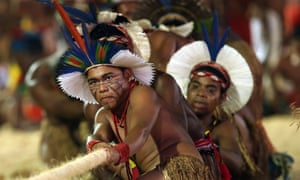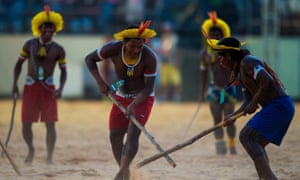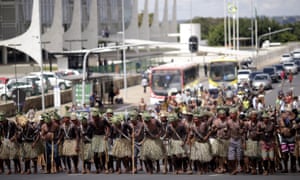2015 World Indigenous Games
A complete structure for a large international event
Etnias nacionais

Assuriní / Bororo Boe / Guarani Kaiowá / Javaé Itya Mahãdu / Kamayura / Karajá / Kayapó Mebêngôkre /Kyikatêjê/Parakatêjê / Matis / Paresi / Pataxó / Tapirapé / Terena / Wai Wai / Xavante / Xerente / Kaingang / Manoki / Kura Bakairi / Kanela / Kuikuro / Erikibaktsa / Mamaindê
Confirmed Countries

Argentina / Bolívia / Canadá / Chile / Colômbia / Costa Rica / Estados Unidos / Etiópia / Filipinas / Finlândia / Guatemala / Guiana Francesa / México / Mongólia / Nicarágua / Nova Zelândia / Panamá / Paraguai / Peru / Rússia / Uruguai /
Etnias Tocantinenses

Javaé Itya Mahãdu / Karajá / Xerente
Ethnic groups

In Tocantins, modernity coexists in complete harmony with tradition. Whilst a state capital, Palmas has an indigenous population about 10,000 strong – all with well-preserved cultures and traditions. Tocantins is home to peoples from seven ethnicities – the Krahô, Krahô Canela, Karajá, Karajá Xambioá, Apinajé, Xerente and Javaé peoples. They live in 82 villages, and in all corners of the state.
All in all, 24 Brazilian ethnicities will attend, and so will peoples from the following 22 countries and more:
| ETNIAS NACIONAIS CONFIRMADAS | PAÍSES CONFIRMADOS | ||
| 1 | Assuriní | 1 | Argentina |
| 2 | Bororo Boe | 2 | Austrália |
| 3 | Guarani Kaiowá | 3 | Canadá |
| 4 | Javaé Itya Mahãdu | 4 | Chile |
| 5 | Kamayura | 5 | Colômbia |
| 6 | Karajá | 6 | Congo – Brazzaville |
| 7 | Kayapó Mebêngôkre | 7 | Costa Rica |
| 8 | Kyikatêjê/Parakatêjê | 8 | Equador |
| 9 | Matis | 9 | Estados Unidos |
| 10 | Paresi | 10 | Etiópia |
| 11 | Pataxó | 11 | Paraguai |
| 12 | Tapirapé | 12 | Guatemala |
| 13 | Terena | 13 | Guiana Francesa |
| 14 | Wai Wai | 14 | México |
| 15 | Xavante | 15 | Nicarágua |
| 16 | Xerente | 16 | Nova Zelândia |
| 17 | Kaingang | 17 | Panamá |
| 18 | Manoki | 18 | Peru |
| 19 | Kura Bakairi | 19 | Rússia |
| 20 | Kanela | 20 | Uruguai |
| 21 | Kuikuro | 21 | Venezuela |
| 22 | Erikibaktsa | 22 | Mongólia |
| 23 Mamaindê | |||
Ethnic Groups
 Learn more about the participating ethnic groups, their traditions and preparation for the games
Learn more about the participating ethnic groups, their traditions and preparation for the games
The Games
Following the success of the 2014 FIFA World Cup, Brazil has consolidated its position as a leading host of sporting mega-events. The next challenge it faces is the realisation of the first World Indigenous Games (I-Games 2015, Jogos Mundiais dos Povos Indígenas), a multisport event with over 2,000 participating indigenous athletes from 30 countries that will be taking place in Palmas (TO) from the 23rd of October to the 1st of November. The indigenous peoples, coming from all over the country and the world, will mingle with each other, and be shown the touristic hubs of Palmas – uniting the city and the community with the participants of the games during the first three days, and compete in the next 10.
The first World Indigenous Games are a project conceived by Marcos Terena’s Intertribal Council (ITC), and grew from the national Jogos dos Povos Indígenas that began in 1999. It is a joint effort by the ITC, the Brazilian Ministry of Sport, and the Municipality of Palmas.
Led by the ideal that “Em 2015, somos todos indígenas” (In 2015, we are all indigenous), Palmas, the capital of Tocantins state, is preparing itself to receive dozens of delegations of indigenous peoples from every corner of the earth. The municipal government has gone so far as to create the Extraordinary Secretariat for the Indigenous Games to oversee the organisation of the Games.
As well as peoples from all the Americas, delegations will be arriving from Australia, Russia and the Philippines. From Brazil alone, 24 Indigenous Ethnicities will be taking part.
They will compete in a variety of sporting events, ranging from a few Western-style competitions (football, athletics) to many indigenous traditional games. Some will be played competitively such as canoeing, archery and Corrida de Tora, but there will be a huge number of non-competitive demonstration events in which indigenous peoples have chosen to showcase their living heritage of games. A good example is xikunahity, a football-style game in which the ball is controlled only with the head.
This will run parallel to a comprehensive programme of discourse and celebration of culture, which includes the latest Indigenous People’s Social Forum, activities for indigenous women, lecture series and fairs. Most events will be led by the indigenous peoples themselves and together we will create a festival that brings together the diversity represented in the Games, culture from the Tocantins region and from the World.
|
|
This article is incomplete. (November 2015) |
 |
|
| Native name | Jogos Mundiais dos Povos Indígenas |
|---|---|
| Date | 23 October – 1 November 2015 |
| Location | Palmas, Brazil |
| Organised by | Inter Tribal Council |
| Website | www.i-games2015.com |
The worlds indigenous games is a multisport event, which involves over 2,000 indigenous athletes competing against one another. These athletes come from all across the world to unite and compete fairly in this event (approximately 30 countries) (2015). Throughout the first three days athletes mingle and bond in their area of sport/games before entering the ten-day competition.[1] The Games are governed by the Inter Tribal Council, a Brazilian indigenous peoples NGO that has staged Brazil’s national Indigenous Games since 1996. The first edition of the Games was held in Palmas, Brazil, from October 23 to November 1, 2015. The Games are expected to be held intermittently thereafter, and will feature competitive sports and non-competitive demonstration events.[2] Throughout history the indigenous have had many traditional sports and dances. It is through their history that they have turned these into competitive games and have made it an influential impact on the world and their people’s culture.[3] These games consist of body paint replacing sportswear, bare feet instead of sneakers and a looser conception of competition that comes with little value to winning. Dana.F (2013.) [4]
Contents
History
The world Indigenous Games grew from the Brazilian Indigenous Peoples Games. There have been 12 editions of the National games, during which approximately 1,500 athletes would take part.[5] The world Indigenous games also known as the Indigenous Olympics is similar to any other Olympic games. It started with a variety of sports, traditional openings and closings ceremonies and indigenous participants from all over the world. The first game has made world history and from here on it shall grow and become influential.[6]
Historical BODY PAINT – Body painting is an ancient tradition that carries deep meaning and value to its people. The art contains a high-spirited significance to the Indigenous people thus the reason why they must wear body paint during the games. Spencer.B (2001). It is a sign off respect for their land and all represents all their people in one. Different designs represent different family relationship, social position, tribe, ancestors and tracts of land. For example, Spencer.B (2001) states that In Arnhem Land the people decorate the bodies of young boys for initiation ceremonies. They are painted in tribe/clan totems to the upper body and thighs. Everything little details has a meaning and represents something. This comes down the design, the colour, the placing of design and who it is put on too.[7]
Events and Competitions
The World Indigenous Games consist of many events and competitions. They compete in a variety of sporting events. These include Western style competitions such as football and athletics as well as many traditional games: rustic race, spear toss, traditional canoeing, CORRIDA DE TORA, XIKUNAHATI. Events such as archery, swimming, wrestling and tug of war are also apart of these games.[8] There are a huge number of events that are non-competitive. This is to show and demonstrate the respect of heritage. They do this by playing traditional sports and celebrating with dances. Many other non-competitive events showcase the celebration of their culture. They include this in the games by forming social forums, activities for the indigenous women and lectures and fairs for all to join and listen too. It is expected for indigenous people to run the Olympics however, important guests could be invited to talk or take part somehow in the games. The main reason for the games is to bring all indigenous people together from around the world. This creates diversity to be closer and helps express the indigenous cultures and traditions.
Traditional games
Wild tree-trunk
This game is a crowd favourite, and is similar to a relay. Nine or more participants are expected to sprint 500 metres each around a red dirt arena. Whilst running they carry a 100 kg chunk of tree on their shoulders.
Archery
Participants bodies are covered with traditional paintings and have to be bare chested. They then line up on a palm of leaves with their bows, 40 metres away from their target. Their target is small fish leaping in and out of the water. Those who spear the most fish gain the points. The highest possible score to achieve is done by drilling the arrow right into the eye.
Xikunahati
This particular event resembles football. However no body part but the head is allowed to touch the ball.
Overall these Olympics are not about competition but are about celebration. Dana.F (2013.) [9]
Participating countries
Over 30 countries participate in the Indigenous Games. Within that 30 more that 2000 athletes participate. Some countries that perform in these games are listed below. Marchand, Dawn Marie (2011).[10]
References
- Tecnologia, CRP. “The Games”. http://www.i-games2015.com. Retrieved 2016-05-17.
- Tecnologia, CRP. “The Games”. http://www.i-games2015.com. Retrieved 2016-05-17.
- Cuiaba, Felipe Dana of Associated Press in (2013-11-15). “Indigenous Games in Brazil: ‘competition is a thing for the west'”. the Guardian. Retrieved 2016-05-17.
- Cuiaba, Felipe Dana of Associated Press in (2013-11-15). “Indigenous Games in Brazil: ‘competition is a thing for the west'”. the Guardian. Retrieved 2016-05-17.
- Taylor, Alan. “The World Indigenous Games”. The Atlantic. Retrieved 2016-05-17.
- “Incredible pictures from the first World Indigenous Games held in Brazil”. Business Insider. Retrieved 2016-05-17.
- “Aboriginal Body Painting Art”. Artlandish Aboriginal Art Gallery. Retrieved 2016-05-17.
- Tecnologia, CRP. “I World Indigenous Games – 2015”. http://www.i-games2015.com. Retrieved 2016-05-17.
- Cuiaba, Felipe Dana of Associated Press in (2013-11-15). “Indigenous Games in Brazil: ‘competition is a thing for the west'”. the Guardian. Retrieved 2016-05-17.
- Marchand,, Dawn Marie. (2011). “Circle of Courage Infusion into the Alberta Indigenous Games 2011.”. Reclaiming children and youth.
- “Philippine tribes vie in World Indigenous Games”. Philippine Star. October 15, 2015. Retrieved October 15, 2015.
Further reading
- Douglas, Bruce (October 29, 2015). “World Indigenous Games draw 2,000 athletes amid protests over groups’ rights”. The Guardian. Retrieved November 24, 2015.
- “Tumultuous World Indigenous Games wraps up in Brazil”. Business Insider. November 1, 2015. Retrieved November 24, 2015.
- Fiegerman, Seth (October 31, 2015). “Stunning photos from the first World Indigenous Games in Brazil”. Mashable. Retrieved November 24, 2015.
- “First World Indigenous Games closes in spectacular ceremony in Brazil”. The Independent. November 1, 2015. Retrieved November 24, 2015.
- Monitor, The Christian Science (November 1, 2015). “‘Our life is not a game,’ say World Indigenous Games protesters”. The Christian Science Monitor. Retrieved November 24, 2015.
External links
- Official website
- North American Indigenous Games Council Official Website [1]
- Staff writers. “2006 Indigenous Games wrap up in Denver,” Indian Country Today Indian Country Today Media Network
- North American Indigenous Games 2014 Official Website [2]
Indigenous Sports in the 2015 Games

Archery

Spear Toss

Tug of War

100m Rustic Race
Indigenous Sports in the 2015 Games

Archery

Spear Toss

Tug of War

100m Rustic Race

Traditional Canoeing

Corrida de Tora

Wrestling

Xikunahati
Indigenous Sports in the 2015 Games

Archery

Spear Toss

Tug of War

100m Rustic Race

Traditional Canoeing

Corrida de Tora

Wrestling

Xikunahati

Association Football

Athletics

Swimming
World Indigenous Games draw 2,000 athletes amid protests over groups’ rights
Competition among people from more than 20 countries comes as tensions climb in Brazil between indigenous cultures and people of European descent

Few sporting pleasures can rival that of the post-victory brag.
Shortly after the Kuikoro had seen off their Amazonian rivals, the Karajá, in arguably the most hotly anticipated event of the first World Games for Indigenous Peoples, the tug-of-war, one of the athletes could not resist emphasising the ease of their 40-second victory.
“It was really simple,” Pique Kuikoro said. “To win, you just have to stay prepared, breathe at the right time and keep your feet planted in the sand.”
Not all the games at this nine-day event in Palmas, a sleepy city in the sweltering agricultural heartland of Brazil, are quite so straightforward.
There’s football, of course, and archery, but also spear-throwing, log-carrying and xiknahiti – a game that’s like football but played on all fours and only with the head.
Almost 2,000 competitors from over 20 countries, from the Aeta people of the Philippines to the Neyihaw of Canada’s Saskatchewan province have gathered for a series of sporting contests billed as the indigenous Olympics.
Unlike the Olympics, the goal of the event is not to win medals – after all, every participant will be entitled to one – but to raise awareness of indigenous culture worldwide.
But it comes at a time when tensions are on the rise across Brazil between indigenous communities, who comprise around 0.5% of the country’s 200 million people, and those of European descent.
According to the Catholic church’s Missionary Council for Indigenous Peoples (Cimi), 138 indigenous people were killed in clashes over land last year, a rise of 130% over 2013.

On Saturday, a protester from the Enawenê-Nawê people in the central-western state of Mato Grosso was shot during a confrontation with a group of farmers and lorry drivers.
Last Thursday, a group of more than 100 activists from indigenous groups and social movements invaded the local assembly in Mato Grosso do Sul to call for a boycott of the state’s agricultural products due to a land dispute.
“Given the context of the current situation in Brazil, we are strongly critical of these games,” Cléber Buzzato, the executive secretary of Cimi, said. “The government is trying to promote the idea that we celebrate indigenous peoples, while in reality both their rights and sometimes their actual bodies are under attack.”
The games have coincided with a string of protests against PEC215, a constitutional amendment currently being debated in congress which would strip the federal government of its powers to demarcate indigenous territories, handing them instead to a legislature stacked with deputies funded by the agricultural industry. It would also grant congress the power to revise the boundaries of pre-existing reserves.

At present, FUNAI, the indigenous affairs agency, along with various other government bodies, demarcates the land in conjunction with indigenous communities. However, the slow pace of the process has come under severe criticism from indigenous rights’ activists.
Representatives of the agricultural lobby, however, argue that the main problem is that no one represents the interests of the landowners and food producers. For Luís Carlos Heinze, a federal deputy for the rightwing Partido Progressista (PP) from the southern state of Rio Grande do Sul, the current demarcation system, established by former president Lula da Silva, is “a mess”.
“In my state alone you have 38 lawsuits against the government,” he said. “Imagine, you have worked the land for three, four or five generations, then some government anthropologists come along and kick you off your land.”

As an example, Heinze cited the government’s attempt to create the Mato Preto indigenous reserve in Rio Grande do Sul. “Over 300 families live there; landowners, producers who have been there since the last century. Now they want them out to make way for an indigenous community. If I stole your house, would you be happy with that?”
Padre Ton, a former deputy from the ruling Partido dos Trabalhadores (PT) who led the indigenous peoples’ parliamentary front, said PEC 215 is likely to win congressional approval, but could still struggle in the senate.
“The government is weak at the moment, and it has to cut some deals with the agricultural lobby,” he said. “There are very few people in congress who defend indigenous rights.”
Ton argues that tension between landowners and indigenous peoples is likely to rise if the amendment is passed. “The bill is designed to cater to the interests of the major landowners and the mining corporations. The PEC will increase the conflict,” he said.











































